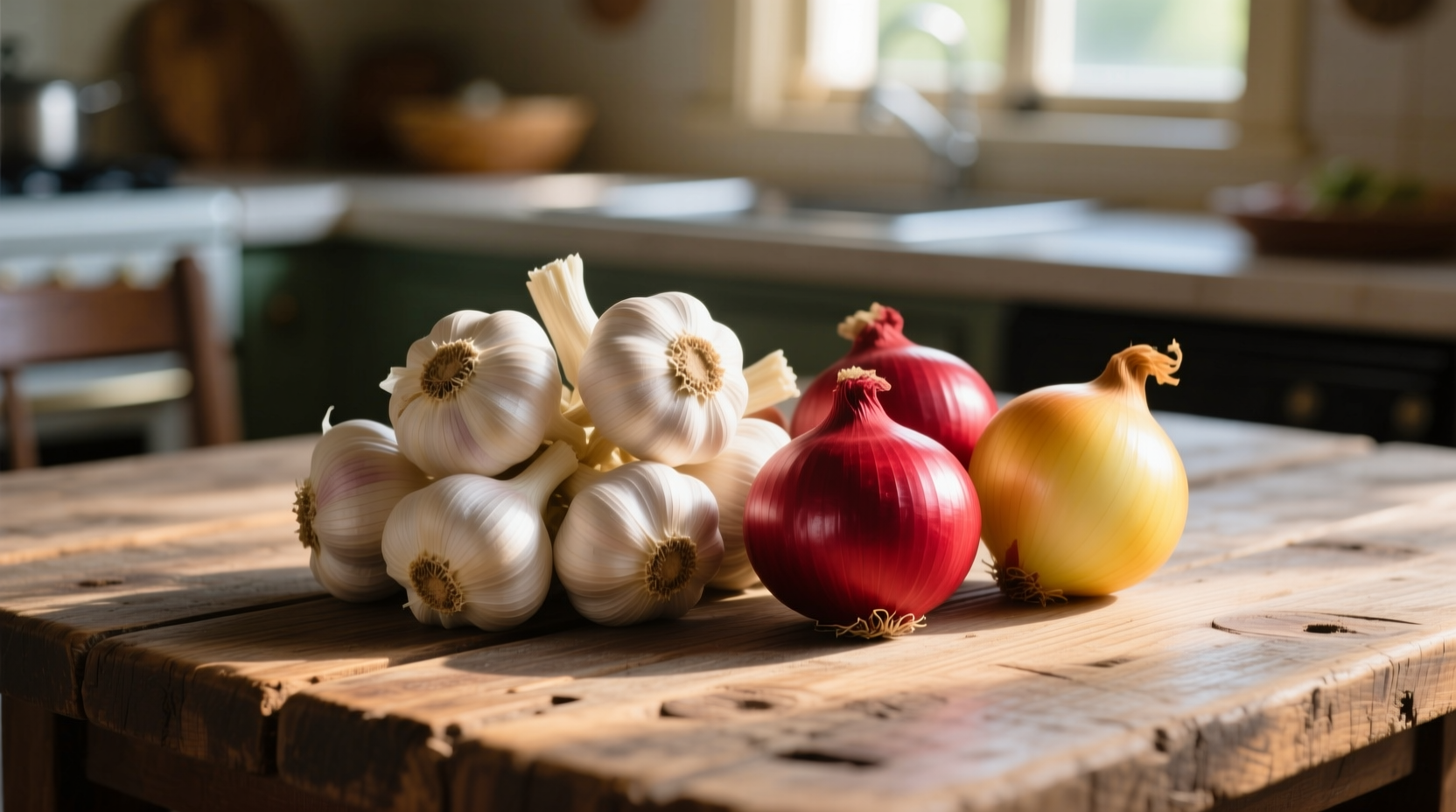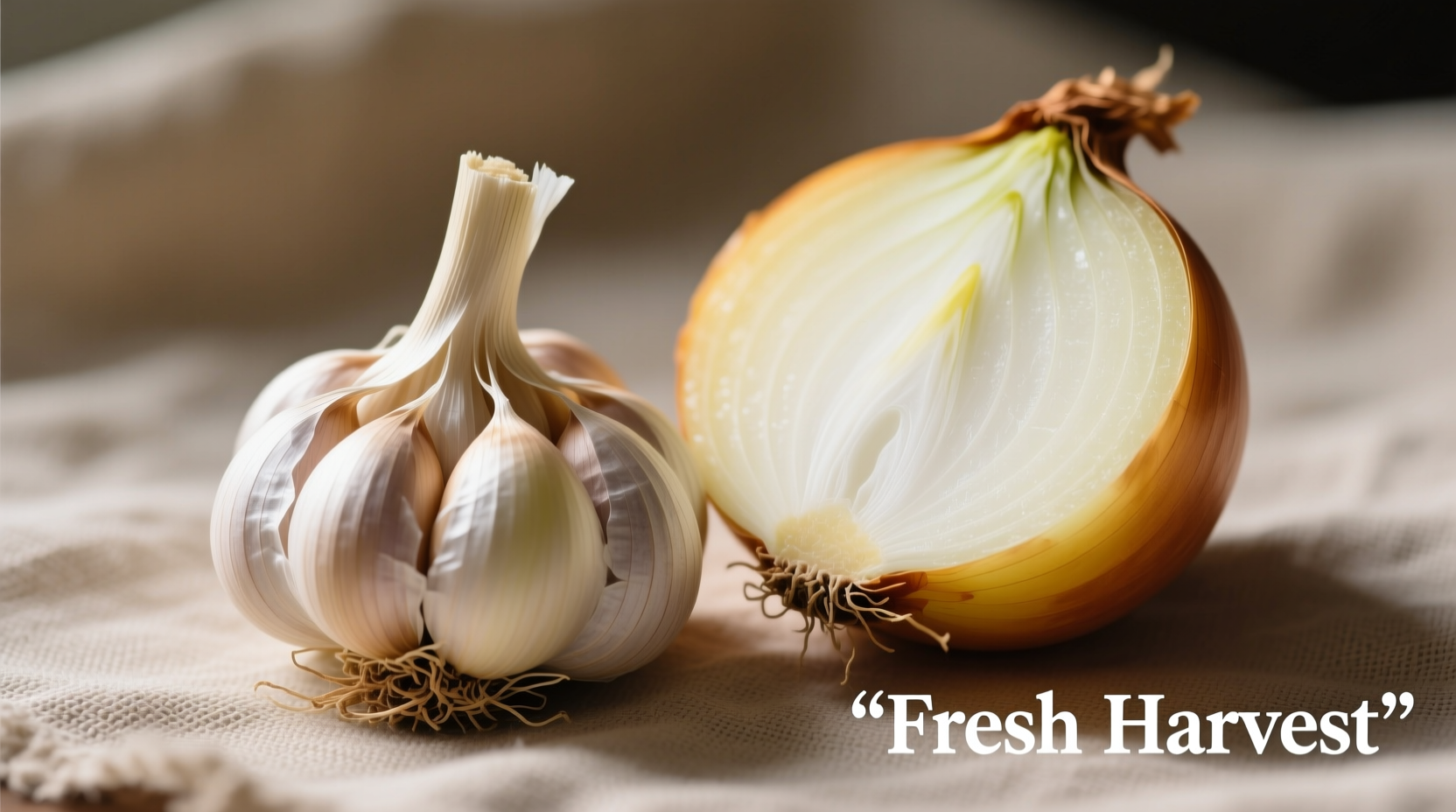Understanding the Garlic and Onion Confusion
Many home gardeners and cooks search for “garlic onion” expecting a hybrid plant that combines both flavors. This misconception likely stems from seeing these ingredients used together in countless recipes or hearing the phrase “onions and garlic” frequently. The reality is simpler: garlic (Allium sativum) and onions (Allium cepa) are separate members of the allium family with unique characteristics.
According to the USDA Agricultural Research Service, while both belong to the Allium genus, they’re distinct species with different chromosome counts and growth patterns. This biological distinction explains why you can’t find true “garlic onions” at nurseries or farmers markets—they simply don’t exist as a single plant variety.
Key Differences Between Garlic and Onions
| Characteristic | Garlic (Allium sativum) | Onions (Allium cepa) |
|---|---|---|
| Botanical Structure | Cloves arranged in a bulb | Concentric layers forming a single bulb |
| Growing Season | Fall planting, summer harvest | Spring planting, summer/fall harvest |
| Flavor Profile | Pungent, spicy when raw; nutty when roasted | Sharp when raw; sweet when caramelized |
| Soil pH Preference | 6.0-7.0 | 6.2-6.8 |
| Storage Life | 6-8 months when properly cured | 2-4 months for standard varieties |
Can You Grow Garlic and Onions Together?
While you can’t grow a “garlic onion” hybrid, many gardeners successfully plant garlic and onions in the same garden bed. However, agricultural experts from Cornell University’s Cooperative Extension warn that planting them together requires careful planning due to their different growing requirements.
Garlic needs a cold period to form proper bulbs, typically planted in fall, while most onions are spring-planted as sets or seeds. When interplanting, maintain at least 6 inches between garlic and onions to prevent competition for nutrients. Both benefit from well-draining soil rich in organic matter, but garlic prefers slightly more acidic conditions.
One significant consideration: both attract similar pests like onion maggots and thrips. The University of California Integrated Pest Management Program recommends rotating allium crops every 3-4 years to prevent pest buildup, rather than planting them together repeatedly in the same location.

Culinary Synergy: Why Recipes Combine Garlic and Onions
Professional chefs consistently use garlic and onions together because their flavor compounds complement each other perfectly. Food scientist Dr. Harold McGee explains in On Food and Cooking that onions contain sulfur compounds that create sweetness when cooked, while garlic’s allicin provides pungency that mellows into nuttiness.
For optimal flavor development, culinary experts recommend this sequence:
- Start with onions in medium heat to build foundational sweetness
- Add garlic 2-3 minutes later to prevent burning (garlic scorches faster)
- Continue cooking until both are translucent but not browned
Common Misconceptions Clarified
“Elephant garlic is a garlic-onion hybrid” – Despite its name, elephant garlic (Allium ampeloprasum) is actually a type of leek, not a true garlic or hybrid. It has milder flavor and larger cloves than regular garlic.
“Pearl onions with garlic flavor exist” – While some specialty onion varieties have stronger flavors, there are no naturally occurring onions that taste like garlic. Flavor variations come from growing conditions and preparation methods, not hybridization.
“Garlic chives are garlic-onion hybrids” – Garlic chives (Allium tuberosum) are a distinct species with flat leaves and a mild garlic flavor, but they’re not hybrids of garlic and onions.
Practical Gardening Recommendations
If you’re planning to grow both in your garden, follow these evidence-based practices from the Royal Horticultural Society:
- Plant garlic in October-November for best bulb development
- Plant onions in early spring after last frost
- Use separate garden beds if possible to prevent shared pest issues
- Apply nitrogen-rich fertilizer to onions during active growth
- Reduce watering for garlic during final bulb formation
When harvesting, cure both properly but separately—garlic needs warmer, drier conditions (75-80°F) while onions cure best at slightly cooler temperatures (70-75°F). Proper curing dramatically extends storage life for both.
Frequently Asked Questions
Can garlic and onions cross-pollinate if planted together?
No, garlic and onions cannot cross-pollinate as they belong to different species with incompatible genetics. Garlic (Allium sativum) and onions (Allium cepa) have different chromosome counts that prevent hybridization. This is confirmed by research from the USDA Agricultural Research Service.
Why do recipes often call for both garlic and onions?
The combination creates layered flavor complexity—onions provide sweetness when cooked while garlic adds pungency that mellows into nuttiness. Food science research shows their sulfur compounds interact to create more complex flavor molecules than either produces alone, forming the aromatic foundation for countless global cuisines.
Can I substitute garlic for onions or vice versa in recipes?
While possible in some applications, they aren’t direct substitutes due to different flavor profiles. Garlic has stronger, spicier notes while onions provide more sweetness. For milder garlic flavor, use roasted garlic; for onion-like sweetness with garlic, try shallots. The University of Illinois Extension recommends adjusting quantities when substituting as garlic is typically used in smaller amounts than onions.
Do garlic and onions share common pests and diseases?
Yes, both are susceptible to onion maggots, thrips, and white rot fungus. The University of California Integrated Pest Management Program advises rotating allium crops every 3-4 years and avoiding planting them in the same location consecutively to prevent pest buildup and soil-borne diseases.











 浙公网安备
33010002000092号
浙公网安备
33010002000092号 浙B2-20120091-4
浙B2-20120091-4